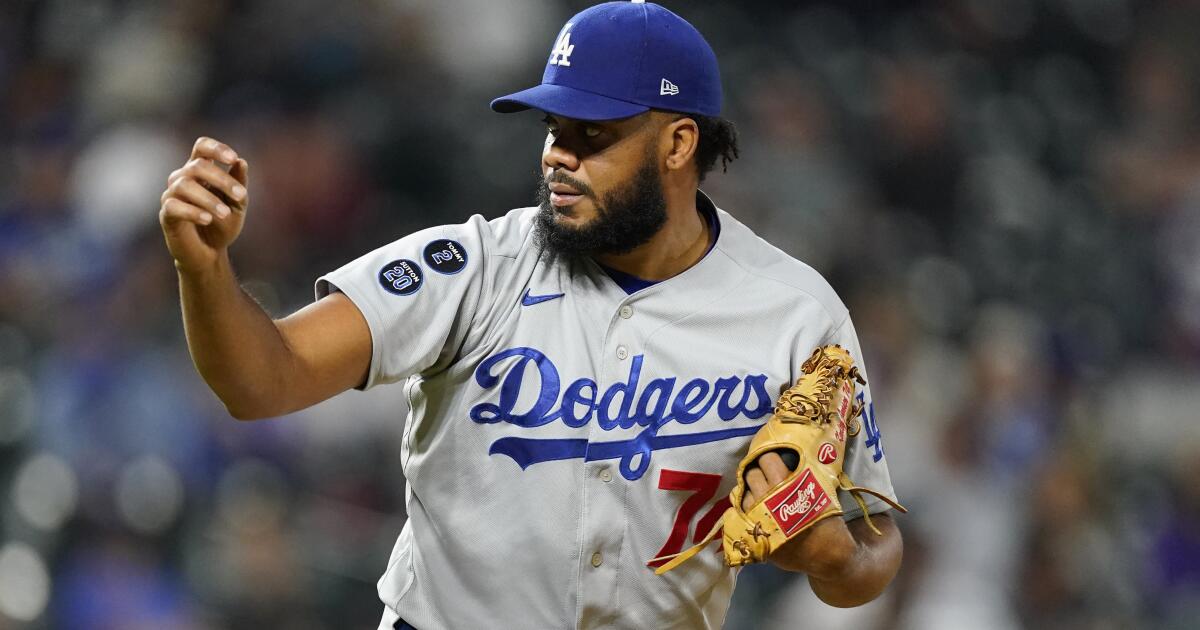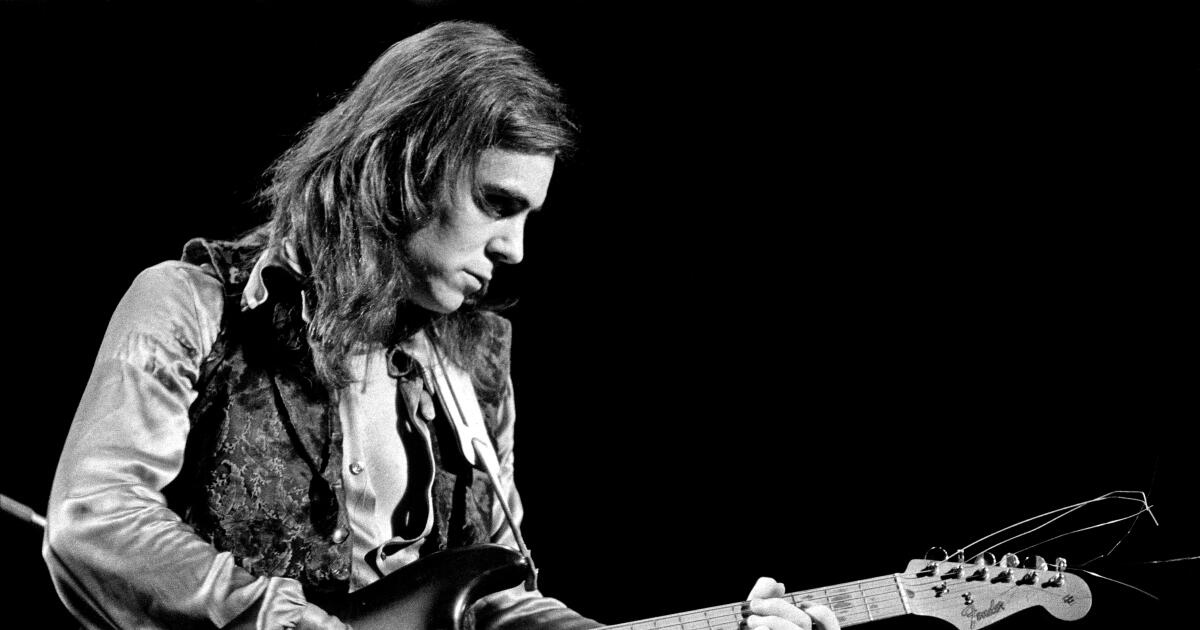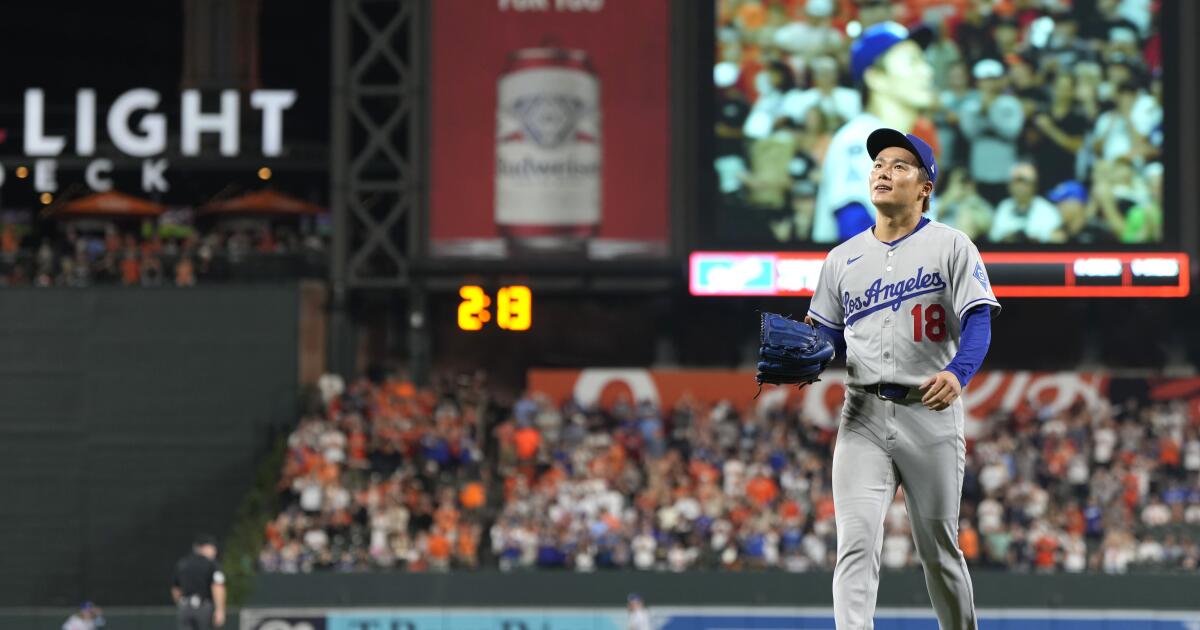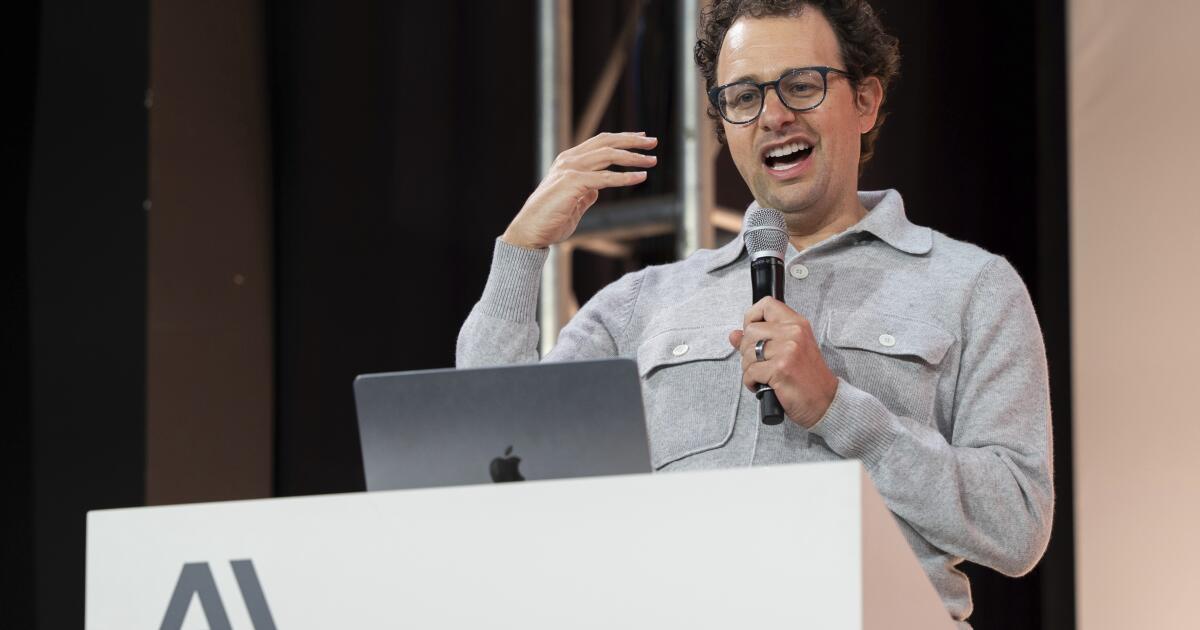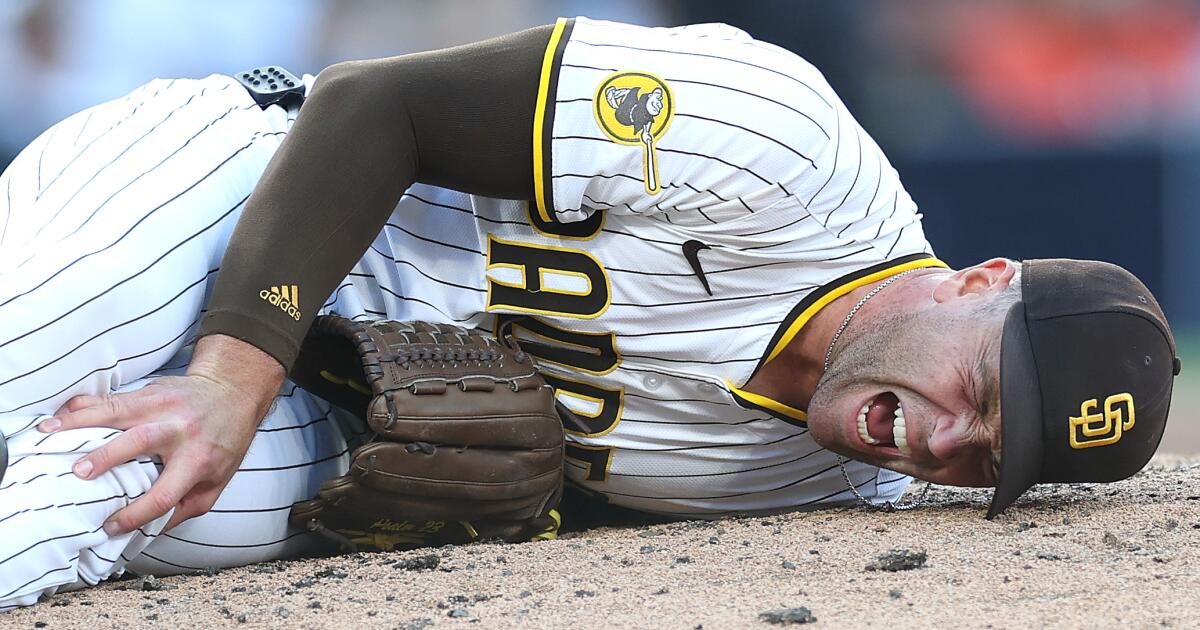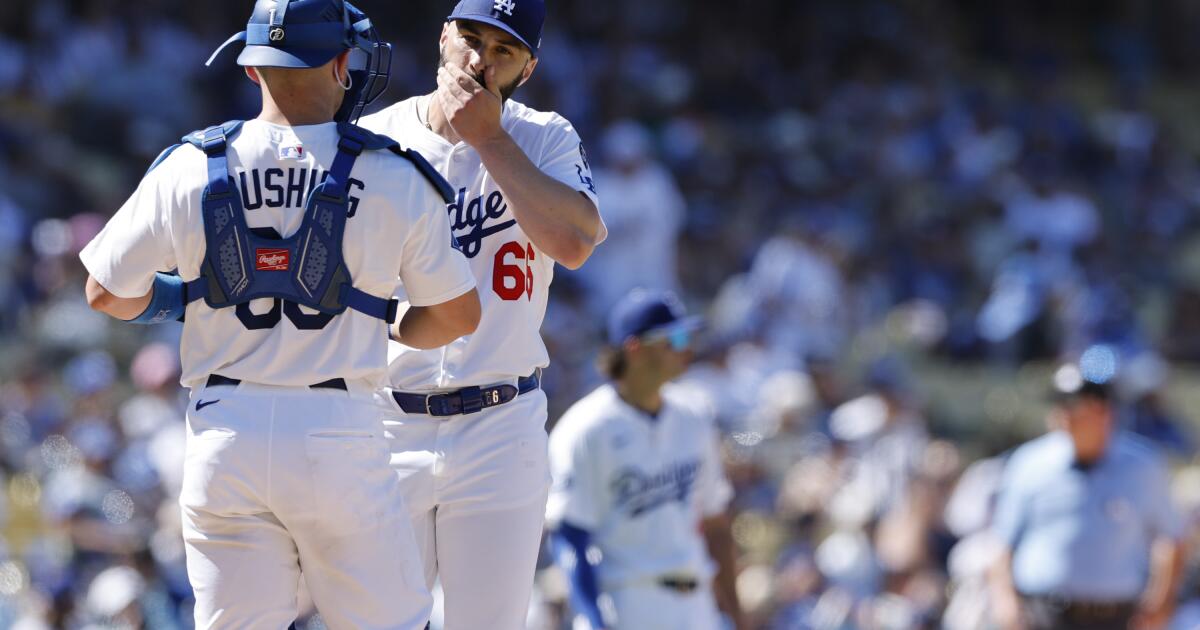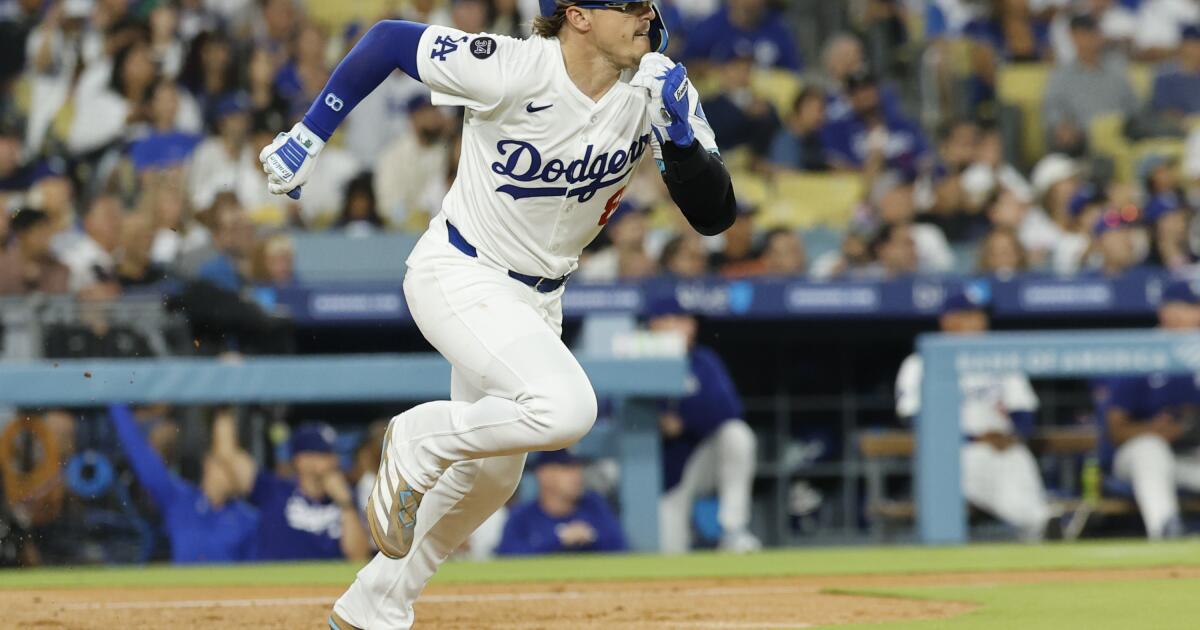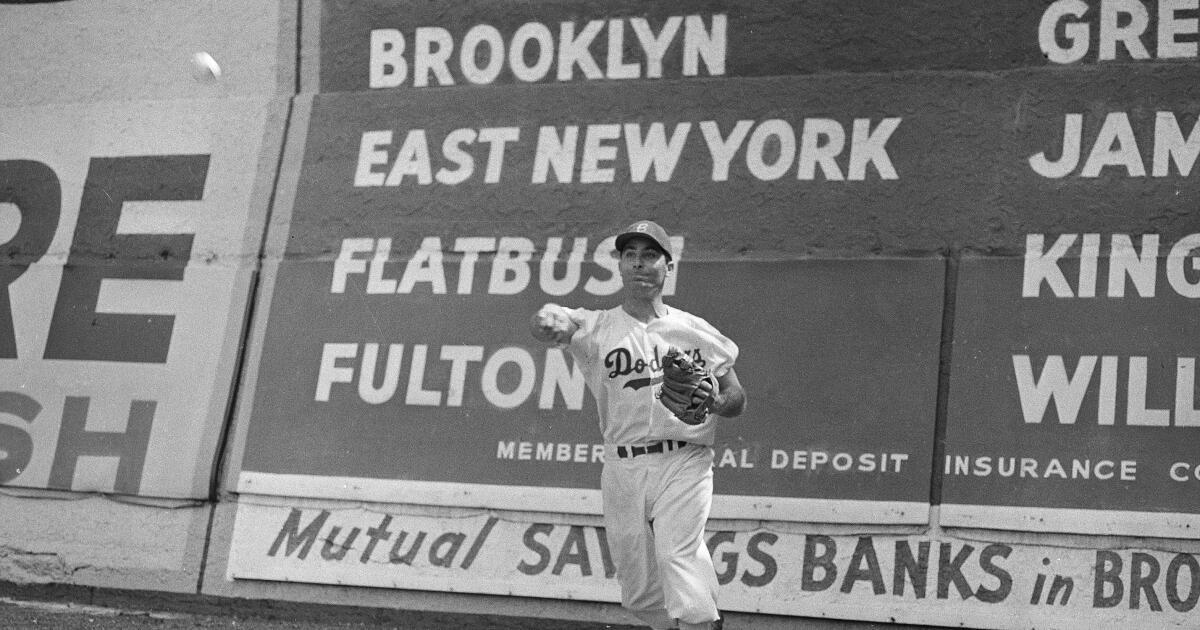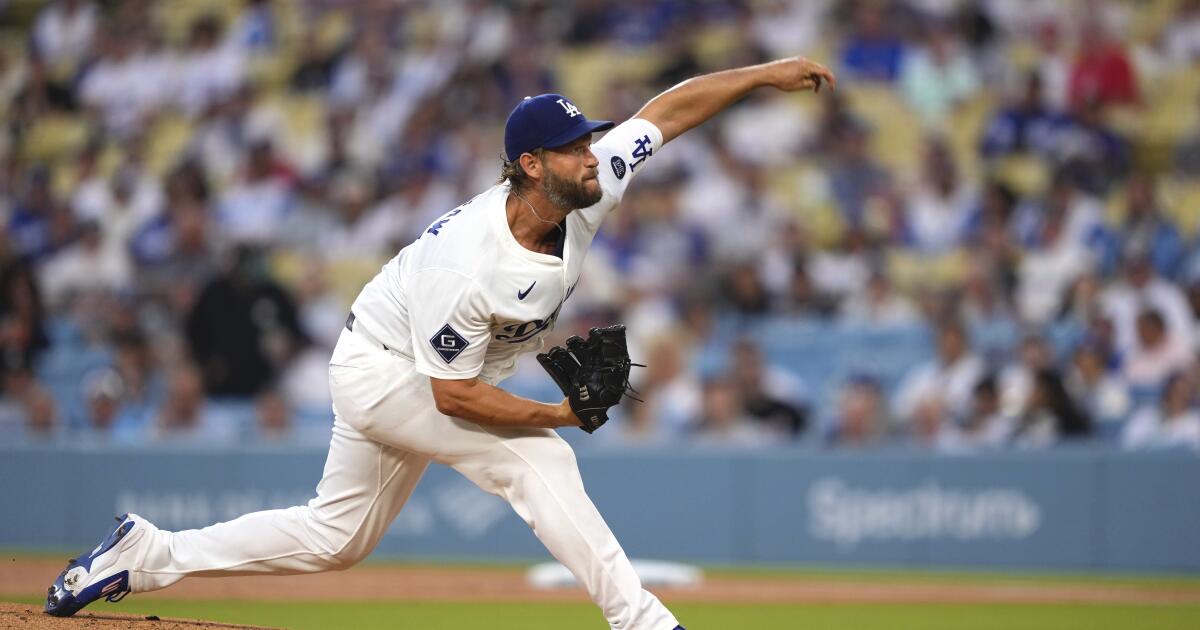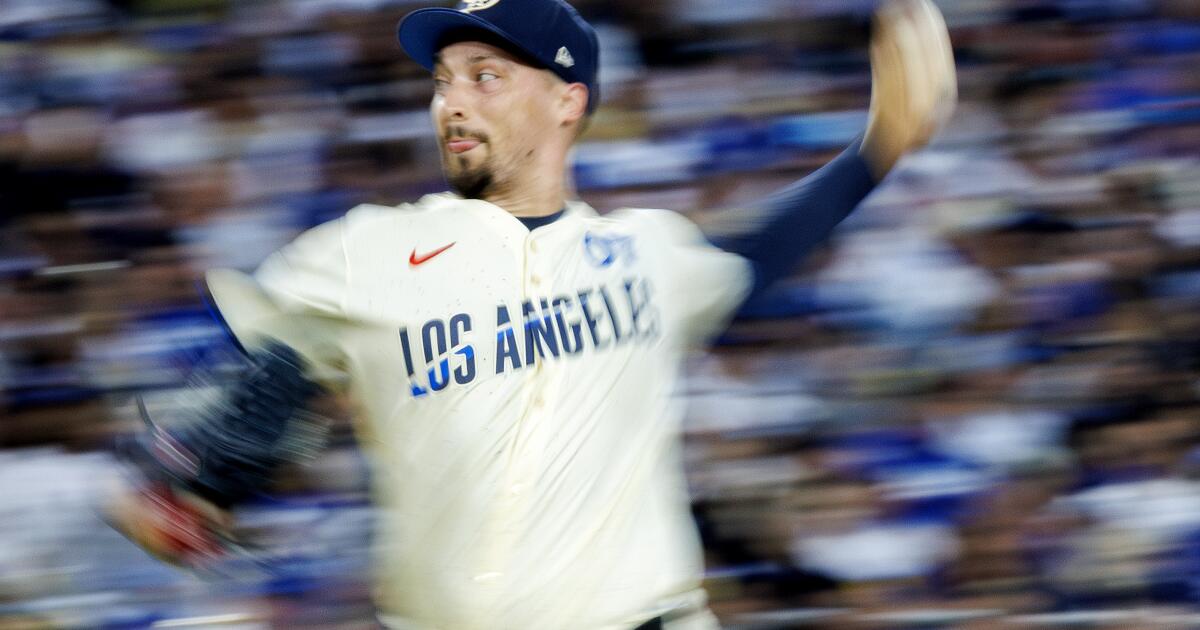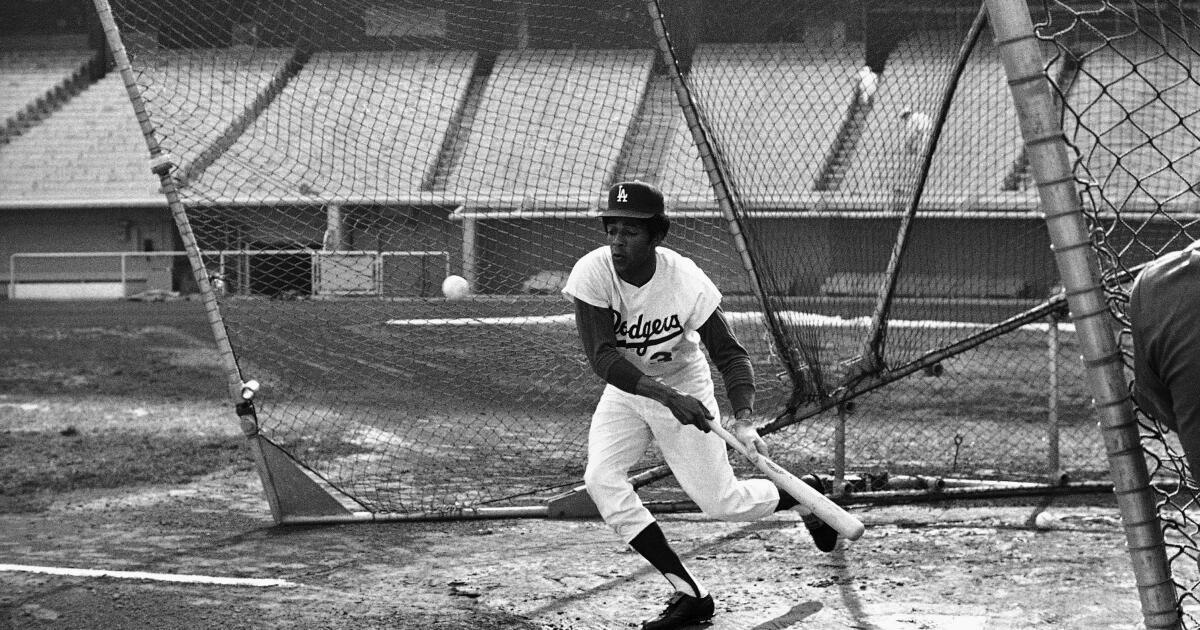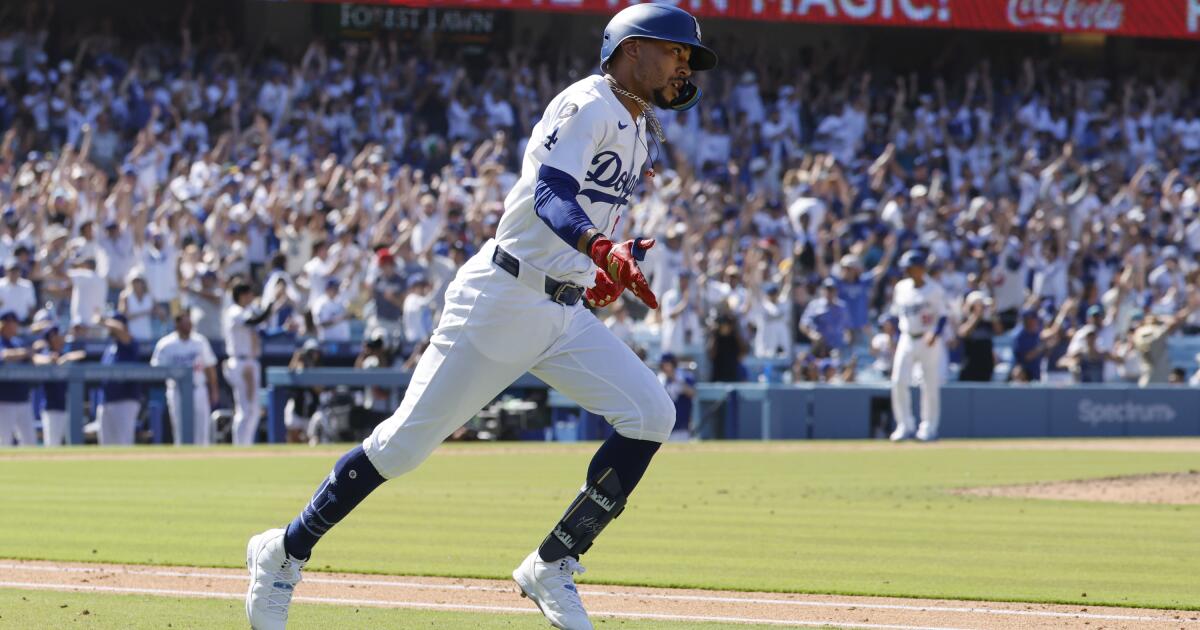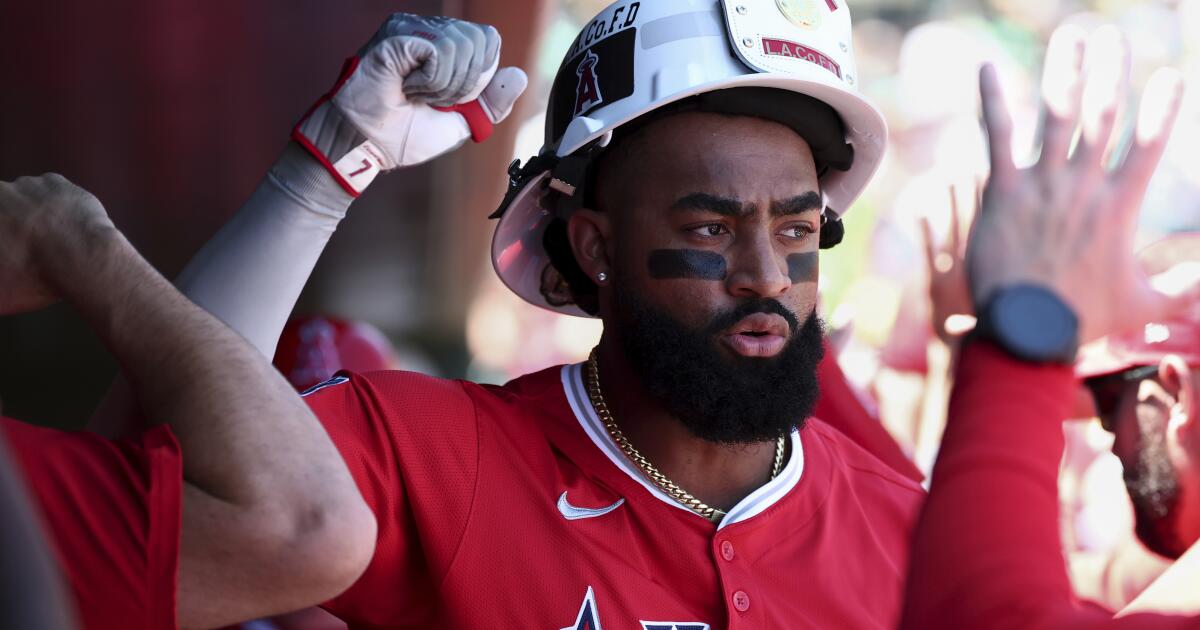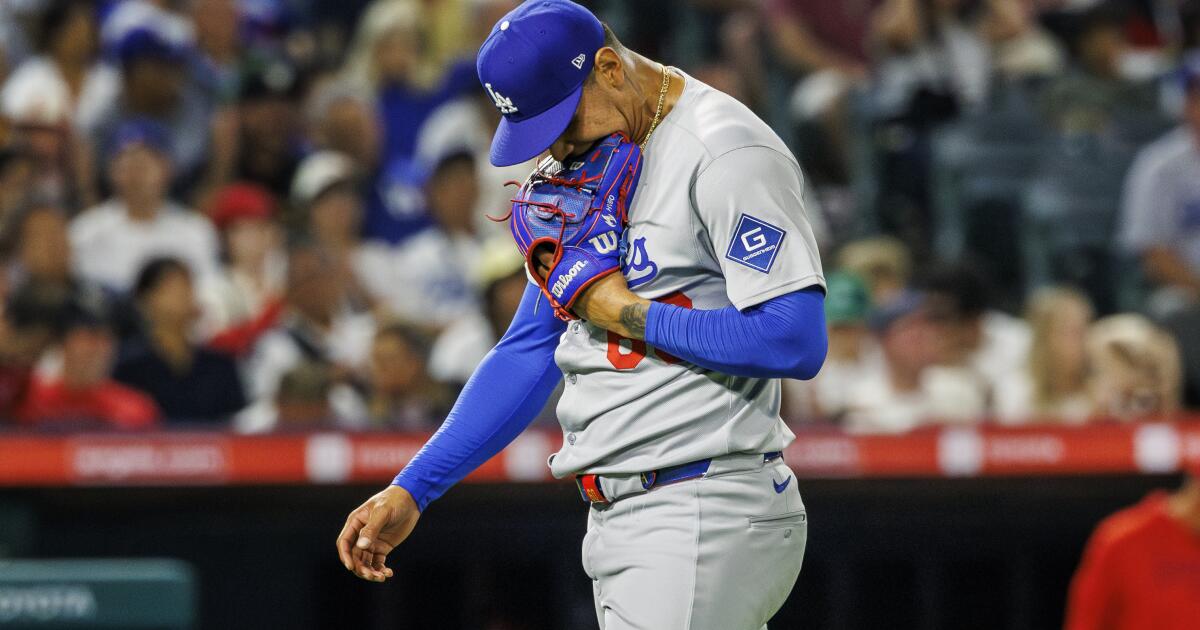Dodgers Dugout: The 10 best relief pitchers in Dodgers history
Hi, and welcome to another edition of Dodgers Dugout. My name is Houston Mitchell. Here’s a bonus edition of the newsletter as we continue to look at the top 10 Dodgers at each position.
Newsletter
Are you a true-blue fan?
Get our Dodgers Dugout newsletter for insights, news and much more.
You may occasionally receive promotional content from the Los Angeles Times.
Top 10 relief pitchers
Here are my picks for the top 10 relief pitchers in Dodgers history, followed by how all of you voted. Numbers listed are with the Dodgers only. Click on the player’s name to be taken to the baseball-reference.com page with all their stats.
1. Kenley Jansen (2010-21, 37-36, 2.37 ERA, 350 saves, 164 ERA+, 3-time All Star)
Really, it’s hard to find anyone else who should be named the best Dodgers reliever. Let’s look at his 2017 season: 68.1 innings, 41 saves, 5-0, 44 hits, only seven walks, 109 strikeouts. He finished fifth in Cy Young voting and 15th in MVP voting. He pitched in 701 games in relief for the Dodgers; the next closest is 250 games behind him.
I wrote a lot about Jansen when he was with the Dodgers. Suffice to say he had an incredible career with the team and it’s nice to see him having a good season with the Angels this season. He has pitched in 928 games and has 473 career saves, Hall of Fame numbers.
2. Ron Perranoski (1961-67, 54-41, 2.56 ERA, 100 saves, 132 ERA+)
For all the praise (much deserved as it is), Sandy Koufax and Don Drysdale get for pitching the Dodgers to three World Series appearances and two titles in the 1960s, people sometimes overlook the fact that waiting in the wings in case one of them, or some other starter, faltered late was Perranoski. He finished fourth in MVP voting in 1963 after going 16-3 with a 1.67 ERA and 21 saves in a league-leading 69 games and led the league in games pitched three times, often pitching more than 100 innings. When the Dodgers swept the Yankees in the 1963 World Series, they used only four pitchers: starters Koufax, Drysdale and Johnny Podres, and Perranoski in relief.
He later served as Dodger pitching coach from 1981-94. He died in 2020 at 84.
3. Jim Brewer (1964-75, 61-51, 2.62 ERA, 126 saves, 127 ERA+, 1-time All Star)
Brewer became the closer in 1968 and remained in the job through the 1973 season.
Brewer had four terrible seasons for the Cubs before the Dodgers acquired him before the 1964 season. He wasn’t expected to make the team, but had such a good spring training that the Dodgers traded reliever Larry Sherry to make room for him
He had a good season, but didn’t pitch in too many games where the Dodgers were leading. He had two pitches, a fastball and curve, neither of which set the world on fire. In spring training in 1965, he was experimenting with a screwball, but couldn’t make it work. The Dodgers played the Braves in an exhibition game, and Brewer asked legendary Braves left-hander Warren Spahn how he threw the screwball.
“I had been working on a screwball but never felt confident enough to use it in a game. I approached Spahn and asked him for some advice,” Brewer told the Sporting News in 1968. “He never said a word. He just took a baseball out of his pocket, showed me his grip and how he released it. I had been releasing the ball off my middle finger, but he showed me how he let the ball go off his index finger which gave much more velocity to the pitch.”
Elbow pain, perhaps from his new pitch, limited him in 1965 and 1966, but in 1967 he was a new pitcher. Used as a setup man, he pitched 100 innings and had a 2.68 ERA. The next season he became the closer and had sub-two ERAs in 1971 and 1972.
Despite a strong 1973 season, when he made the All-Star team, injuries were beginning to pile up for Brewer. So, before the 1974 season the Dodgers acquired Mike Marshall and named him the new closer. After the season, Brewer asked to be traded. In July 1975 the Dodgers sent him to the Angels for reliever Dave Sells. He retired after the 1976 season because of a torn elbow ligament.
Brewer died two days after his 50th birthday, when, on Nov. 14, 1987, he was killed in a head-on collision.
4. Eric Gagné (1999-2006, 25-21, 3.27 ERA, 161 saves, 125 ERA+, 3-time All Star, 2003 Cy Young Award)
The numbers above are a little misleading, because they include his time as a poor starting pitcher. If you limit it to just his seasons as a reliever, his ERA drops to an amazing 1.82, a 221 ERA+.
In 1999, Gagné was the top pitching prospect in the Dodgers organization as a starting pitcher. He looked like he would be a solid No. 2 or 3 man in the rotation for many years. However, he struggled in the majors, going 4-6 with a 5.15 ERA in 19 starts in 2000 and 6-7 with a 4.75 ERA in 24 starts in 2001. He gave up a hit an inning and his strikeout rate was 7.7 per nine innings. A far cry from what he eventually would do.
Jeff Shaw retired before the 2002 season, leaving the Dodgers without a closer. Manager Jim Tracy had an idea: What about Gagné? People often forget what a controversial move it was at the time. Take one of your top starting pitcher prospects and make him the closer?
Then Gagné immediately became the best closer in the game. He dominated in spring training. He started the season with 10 consecutive saves. He was named to the All-Star team. He finished the year with 52 saves.
And he captured the imagination of Dodgers fans, because he was the first closer the team ever had who could come in and just dominate batters, blowing the ball by them. He struck out 114 in 82 1/3 innings.
When Gagné was in his prime, no one left the game early because they wanted to see him close it out. If the Dodgers had a narrow lead, people would stand as soon as the eighth inning ended, anticipating his arrival. As soon as Guns N’ Roses’ “Welcome to the Jungle” started playing, the stadium would erupt in cheers and whistles. Very few Dodgers in history received that type of reception every time. Gagné became known as “Game Over,” with Game Over T-shirts worn throughout the stadium.
In 2003, Gagné finished with a 1.20 ERA, 55 saves (no blown saves), 137 strikeouts and only 20 walks in 82.2 innings. He gave up only 37 hits. He was named the NL Cy Young winner. It is still the greatest season by a closer in history. From 2002-04, Gagné had 84 consecutive saves, still the record.
Gagné’s career quickly unraveled though. He hurt a knee in spring training before the 2005 season. He came back, hurt his arm and had season-ending Tommy John surgery. He pitched in only two games in 2006 and then hurt his back, needing season-ending surgery for two herniated disks.
After the season he became a free agent and bounced around to three teams. His last season was in 2008 with Milwaukee. He made a comeback attempt with the Dodgers in 2010, but after six runs in two spring training innings, he retired.
Some shine of the streak was dulled when he was named in the Mitchell Report as a player who had used performance-enhancing drugs. He said he used human growth hormone and apologized to the fans, saying he started using it when he was injured in 2005, after the streak. Gagné talked about it in 2010.
“It changed it a lot for a couple of years,’’ Gagné said. “But now, you come to grips, where you know what, it is what it is. You have to accept it and just go on. You have to keep going and enjoy baseball, get people out and get back to basics. There are a lot of regrets. But the whole time I was with the Dodgers, it was an unbelievable time. The Mitchell Report and everything is negative. It’s always going to be on my resume for the rest of my life.”
5. Hugh Casey (1939-42, 1946-48, 70-41, 3.34 ERA, 49 saves, 115 ERA+)
It’s hard to compare relievers before the modern era of closer to relievers since that era began. Back then, saves weren’t even a stat (they were rewarded retroactively) and relievers would regularly pitch multiple innings.
Which brings us to Casey, who was the first real “closer” in Dodger history. He led the NL with 13 saves in 1942 before losing three seasons to World War II. He came back to go 11-5 with five saves in 1946 and then led the NL with 18 saves in 1946. Casey was a starter until manager Leo Durocher switched him to relief midway through the 1941 season. It made all the difference in the world for Casey, who thrived in the role. In 1942, the Dodgers were training in Cuba and author Ernest Hemingway was there. Some team members and Hemingway were having some drinks when Hemingway challenged Casey to a fight. Casey refused, so Hemingway sucker punched him. Casey then pretty much beat up Hemingway until the author punched Casey in the groin and declared the fight a draw.
Casey had a difficult life after baseball, and died at 37 in 1951. For a great bio of Casey, click here.
6. Jay Howell (1988-92, 22-19, 2.07 ERA, 85 saves, 170 ERA+, 1-time All Star)
Howell, who had been Oakland’s closer for two seasons, had a terrible 1987, going 3-4 with a 5.89 ERA. After the season, he was part of the three-team deal in which the Dodgers traded Bob Welch, Matt Young and Jack Savage and received Howell, Alfredo Griffin and Jesse Orosco.
Those who followed the pitchers and “sticky substances” controversy a couple of season ago and were fans of the 1988 Dodgers had to be reminded of Howell, who was suspended during the NLCS for using pine tar on his glove. It had been cold and rainy in New York, and Howell did it to get a better grip on the ball. He was suspended for three games (it was reduced to two the next day), an event that seemed to anger the team rather than make them fall apart. He had 21 saves that season. He pitched in Game 3 of the World Series in Oakland, and after retiring the first batter in the bottom of the ninth, gave up the game-winning homer to Mark McGwire. Afterward, some of the A’s said how happy they were to see Howell and his “Little League curveball” come into the game. That was bulletin board material from Tommy Lasorda, who didn’t hesitate to bring in Howell the next day. He was brought in with the Dodgers leading, 4-3 with two out in the seventh inning. The A’s had runners on first and second. Griffin made an error on a ball hit to short, loading the bases, bringing up McGwire, who popped to first on the first pitch. Howell finished out the 2-1/3 inning save. Can you imagine a closer pitching that long today?
Howell put together five good-to-great seasons with the Dodgers, then pitched a season with Atlanta and a season with Texas before retiring.
7. Clem Labine (1950-60, 70-52, 3.63 ERA, 81 saves, 113 ERA+, 2-time All Star)
Labine relied on a sinker as his main pitch, telling Peter Golenbock in the book “Bums,” “They go to swing at it, and it drops on you, and you get the top of the ball. So, you’re not gonna hit a lot of line drives off of me, just a lot of groundballs. And don’t forget who we had scooping them up: Gilly, Robinson, Reese and Cox.” Labine pitched in four games in the 1955 World Series, winning one and saving one.
Sadness seemed to be a constant in Labine’s life after he retired. He once told Roger Kahn, “You heard about Jay? My son Clement Walter Labine Jr. He stepped on a mine in Vietnam and blew his leg off. The Marines sent a car to our house. Barbara [Clem Sr.’s wife] was away. I was out playing golf. My brother-in-law saw this Marine car and went over and said, ‘Is this about Jay, Clem Labine, Jr.?’ The Marine officer was very polite. He asked who was he talking to and my brother-in-law said he was Jay’s uncle and the Marine said that under the rules he couldn’t say anything. Next of kin only. So when they came and got me off the golf course, the first thing they said was, ‘Jay’s been hurt, but he’s alive’. He wrote me a letter from the hospital. It was so calm and matter-of-fact. If I hadn’t been a ballplayer, I wouldn’t have been away all the time. But the traveling cost me all of it, Jay growing up. If I hadn’t been a ballplayer, I could have developed a real relationship with my son. The years, the headlines, the victories, they’re not worth what they cost us. Jay’s leg.”
“Clem Labine was one of the main reasons the Dodgers won it all in 1955,” Vin Scully said after Labine died at age 80 in 2007. “He had the heart of a lion and the intelligence of a wily fox. And he was a nice guy, too.”
8. Tom Niedenfuer (1981-87, 30-28, 2.76 ERA, 64 saves, 128 ERA+)
Some Dodger fans just remember Niedenfuer as the guy who gave up that home run to Jack Clark. But they are missing the big picture. Niedenfuer was a quality relief pitcher and threw 106 innings that year. He also gave up a game-winning homer to Ozzie Smith earlier in the series. “Looking back on it,” Niedenfuer said in a 2010 interview, “it’s a very proud feeling that your manager had enough confidence in you to be the guy he put in that situation. I wouldn’t trade that for anything in the world because I loved being out there. But when it happened, all I can remember is … you let the team down.”
Niedenfuer was also a key reliever on the 1981 World Series champs, pitching five innings in the World Series, giving up three hits and no earned runs. Niedenfuer lives in Florida with his wife, actress Judy Landers. They have two daughters.
The one thing I remember most about Niedenfuer: After he gave up Clark’s homer, he answered every question from the media after the game. He didn’t hide or go home before reporters arrived. As he said, “Just because I didn’t do my job doesn’t mean you shouldn’t be able to do yours.”
The Dodgers traded Niedenfuer to the Baltimore Orioles on May 22, 1987, for outfielder John Shelby and pitcher Brad Havens.
Niedenfuer took part in our “Ask….” series. You can read that here.
9. Mike Marshall (1974-76, 28-29, 3.01 ERA, 42 saves, 114 ERA+, 2-time All Star, 1974 Cy Young Award)
Marshall was a man of strong opinions. He felt he could pitch pretty much every day, but most of his managers thought he was a nut. Until he hooked up with Walter Alston, who trusted Marshall and told him to just tell him if he couldn’t pitch, otherwise he’d use him as much as possible. And that set the stage for an incredible 1974 season, where Marshall appeared in 106 games, pitching an amazing 208.1 innings in relief, going 15-12 with a 2.42 ERA and 31 saves. He won the Cy Young Award, becoming the first reliever to do so. But because Marshall was so outspoken, and a big proponent for the burgeoning union, he was usually sent packing quickly by teams. The Dodgers traded him in 1976. In all, Marshall spent 14 seasons in the majors, playing for nine teams. He is also a key background character in Jim Bouton’s book, “Ball Four.”
10. Steve Howe (1980-85, 2.35 ERA, 59 saves, 150 ERA+, 1-time All Star, 1980 NL Rookie of the Year)
The tragic story of Steve Howe in 10 sentences:
1. Won Rookie of the Year award in 1980, then developed a major drug problem when given cocaine at the new conference to announce his award.
2. Was on the mound for the final out of the Dodgers’ 1981 World Series title.
3. Had his best season in 1983, when he had 18 saves and a 1.44 ERA in 68.2 innings.
4. Was suspended for the entire 1984 season.
5. Dodgers finally gave up on him midway through the 1985 season.
6. He bounced in and out of baseball for the rest of the 80s before finally appearing to clean himself up.
7. Pitched for six seasons for the Yankees from 1991-96.
8. Was suspended seven times in his career for substance abuse.
9. In 2006, he was killed in a single-car accident when his truck rolled over in Coachella.
10. An autopsy report found meth in his system.
The next 10: Takashi Saito, Larry Sherry, Phil Regan, Joe Black, Alejandro Peña, Jonathan Broxton, Jeff Shaw, Todd Worrell, Ed Roebuck, Vito Tamulis.
The readers’ top 10
There were 2,302 ballots sent in. Thirty-six relievers received at least one vote, the most diverse ballot of all the positions. First place received 12 points, second place nine, all the way down to one point for 10th place. For those of you who were wondering, I make my choices before I tally your results. Here are your choices:
1. Kenley Jansen, 1,088 first-place votes, 22,027 points
2. Eric Gagné, 953 first-place votes, 21,575 points
3. Ron Perranoski, 153 first-place votes, 14,579 points
4. Mike Marshall, 90 first-place votes, 12,052 points
5. Jim Brewer, 9,659 points
6. Steve Howe, 5,868 points
7. Larry Sherry, 10 first-place votes, 5,732 points
8. Clem Labine, 4,017 points
9. Charlie Hough, 3,972 points
10. Jay Howell, 5 first-place votes, 3,965 points
The next 10: Phil Regan, Tom Niedenfuer, Blake Treinen, Todd Worrell, Jeff Shaw, Jonathan Broxton, Takashi Saito, Alejandro Peña, Joe Black, Evan Phillips.
Top 5 managers
Who are your top five Dodgers managers of all time (including Brooklyn)? Email your list, in order from 1 (your selection as the best) to 5 (the fifth best) to [email protected] and let me know. Remember, we are considering only what they did with the Dodgers.
Many of you have asked for a list of people to consider for each position. Here is every person who managed the Dodgers for at least 81 games:
Walter Alston, Billy Barnie, Charlie Byrne, Max Carey, Bill Dahlen, Chuck Dressen, Patsy Donovan, Leo Durocher, Charlie Ebbets, Dave Foutz, Burleigh Grimes, Ned Hanlon, Glenn Hoffman, Davey Johnson, Tommy Lasorda, Grady Little, Harry Lumley, Don Mattingly, Bill McGunnigle, Dave Roberts, Wilbert Robinson, Bill Russell, Burt Shotton, Casey Stengel, George Taylor, Joe Torre, Jim Tracy, John Ward.
And finally
Steve Howe gets the final out of the 1981 World Series. Watch and listen here.
Until next time…
Have a comment or something you’d like to see in a future Dodgers newsletter? Email me at [email protected]. To get this newsletter in your inbox, click here.
